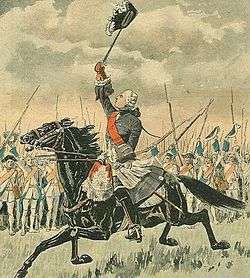François Gaston de Lévis
François-Gaston de Lévis, Duc de Lévis (20 August 1719 – 20 November 1787), styled as the Chevalier de Lévis until 1785, was a French noble and a Marshal of France. He served with distinction in the War of the Polish Succession and the War of the Austrian Succession, and served as a second in command to Louis-Joseph de Montcalm in the defense of New France during the Seven Years' War. Following the surrender of New France in 1760, he served in Europe. After the war he was appointed Governor of Artois, and in 1783 he was made a Marshal of France.
North American military service
In 1756, the Marquis de Vaudreuil was informed that King Louis XV of France was sending the Marquis de Montcalm to take over the French forces in North America, with Lévis as second in command. Vaudreuil wrote back to the king stating that there was no need to send another general, as Vaudreuil disliked the tactics of most "municipal" French generals. When Montcalm arrived in spite of Vaudreuil's protest, the two men developed a dislike for each other. Lévis diplomatically cultivated good relations with both men, and managed to avoid getting dragged into the feuds between the two leaders.
Lévis led the vanguard of the French expedition to Fort William Henry in 1757, and established the siege prior to Montcalm's arrival.
French planning for the 1758 campaign in the French and Indian War continued the disputes between Vaudreuil and Montcalm. Vaudreuil prevailed, and Montcalm was sent to Fort Carillon to defend against an expected British attack, and Lévis was initially slated to lead an expedition to the western forts, leading about 500 French metropolitan troops and then a large force of seasoned French-Canadian militia. Vaudreuil, however, had second thoughts, and dispatched Lévis and his metropolitan troops to support Montcalm at Carillon. Lévis arrived at Carillon on the evening of July 7, as a British army was arriving before the fort. The next day, in a stroke of good fortune for the defenders, the 16,000 strong British army under the command of General James Abercrombie decided to frontally attack the French defenses manned by about 4,000 men, without the benefit of artillery support. In the Battle of Carillon, the British were decisively defeated, with Lévis leading the defense on the French right flank.

When the forces of James Murray arrived to begin the Siege of Quebec, Lévis participated in the early defenses, including the Battle of Beauport. He was then sent to organize the defense of Montreal, and was not present when Quebec fell. Following Montcalm's death at the Battle of the Plains of Abraham, Lévis was appointed commander of French forces in North America. Wintering at Montreal, Lévis managed to rally his troops and train them for a spring offensive aimed at recapturing Quebec in 1760. Marching downstream with the first breaking of the ice, Lévis met the forces of James Murray at the Battle of Sainte-Foy, where Lévis' army won a victory in one of the bloodiest battles ever fought on Canadian soil.[1] This forced Murray to retreat behind Quebec's walls. The lack of artillery and siege equipment precluded any assault on the fortifications of Quebec and Lévis held back, awaiting reinforcements from Europe. With the arrival of a British squadron which then destroyed his support ships on the Saint Lawrence, Lévis was obliged to retreat to Montreal, where Vaudreuil eventually surrendered New France to Amherst's army, which had advanced down the Saint Lawrence River that summer, in early September. Lévis, unhappy with the terms of capitulation, which did not include the traditional "honors of war", decided to burn the regimental colors rather than turning them over to the British.
His various letters for this period were later collected and published by Beauchemin in 1889;[2] letters to him for this period were published by the Abbe Casgrain, a professor at Universite Laval, in 1895;[3] Casgrain had already published in 1891 Les français au Canada : Montcalm et Lévis.[4]
Retirement
Lévis returned to France on parole, and was released for service in Europe by William Pitt. He served in the German campaigns of 1762, and retired from active military service when the war ended in 1763 with the Peace of Paris. He was appointed governor of Artois in 1765. He was promoted to Marshal of France in 1783, and was raised to the inheritable title Duc de Lévis in 1784.
He died in 1787 in Arras, France, and was succeeded as duke of Lévis by his son Pierre-Marc-Gaston, who escaped to England during the French Revolution. His widow and three daughters were sent to the guillotine during the French Revolution.
He left his name to Lévis, Quebec, across the river from Quebec City.
References
- ↑ Stephen Brumwell Redcoats: The British Soldier and War in the Americas, 1755-1763 (NY: Cambridge University Press, 2002), p. 259
- ↑ gallica.bnf.fr: "Lettres du chevalier de Lévis concernant la guerre du Canada (1756-1760)"
- ↑ gallica.bnf.fr: "Lettres de divers particuliers au chevalier de Lévis / publ. sous la dir. de l'abbé H.-R. Casgrain"
- ↑ gallica.bnf.fr: "Les français au Canada : Montcalm et Lévis / par l'abbé H.-R. Casgrain"
Bibliography
- Carillon 1758, Osprey Publishing
- Quebec 1759, Osprey Publishing
External links
- Biography at the Dictionary of Canadian Biography Online
- 1759 From the Warpath to the Plains of Abraham (Virtual exhibition)
- Lettre du Maréchal de Lévis à A M. le Maréchal de Belle-Isle
- Lévis, François-Gaston de, duc de Lévis
- Lévis, François-Gaston de, duc de Lévis

